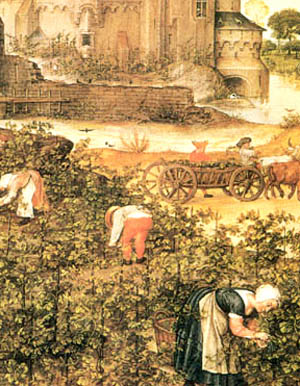 |
Catholic Customs
A Study of the Veil in the Christian Tradition - Part 4
St. Thomas Aquinas and His Teaching
Donald P. Goodman III
4. The veil to 1983.
Did the Fathers’ teaching on the veil take root in Christendom, spreading wherever the Church spread? Or did it fall upon the wayside, or stony ground, or among thorns, and fail to bring forth fruit? (1) I shall now examine the teachings of some great Doctors of the Church on this matter, to see how the doctrine of the Fathers was carried beyond the patristic era and into the Age of Faith.
4.1 St. Thomas Aquinas
4.1.1 The veil in the Summa Theologiae
St. Thomas’s great work, the Summa Theologiae, is so voluminous and universally respected among orthodox theologians that it might be expected to contain some kind of information about every conceivable moral question, the veil not excepted.

The use of the head coverings for women was general in the Middle Ages. Above, men and women working in the vineyards |
The doctrine of the veil, as far as I could see, appears in only one passage, and its mention is relatively matter-of-fact. However, this brevity must not be read as a comment upon the matter’s importance, and St. Thomas’s matter-of-factness may be a proof of the veil’s universal respect and acceptance rather than a statement about its insignificance. It is important to remember that the Summa was conceived difficult as it is to believe today, as a beginner’s theological text; (2) we cannot, therefore, expect every question to be answered with full theological rigor.
Even in this beginner’s text, however, St. Thomas found the topic of the veil important enough to mention, however briefly. Largely, his discussion is a quotation from St. Augustine from his letter to Possidius, which I have already quoted. He then adds to St. Augustine’s comments:
“In this case [of the veil], however, they may be excused [for not wearing it] from sin, if they do not do it from a certain vanity, but because of some contrary custom. Such a custom, however, is not praiseworthy.”
I propose some consequences that can be taken from these words by St. Thomas, which confirm my conclusions from the Church Fathers on the veil.
The first is that he implicitly agrees with St. Augustine on the subject. St. Thomas simply quotes the passage from St. Augustine’s letter without comment; he does not attempt to qualify it or alter it. He therefore endorses it. St. Thomas not only indirectly approves St. Augustine, but doing that, it can be said that he also indirectly agrees with the Fathers – St. John Chrysostom and St. Ambrose – leading up to him. So, I conclude that the veil retains its importance in the Christian world in the writings of St. Thomas.
The next observation is that the text of St. Thomas allows one to induce that the veil continued to be a widespread practice throughout Europe in his time. While contemporary art indicates that a complete binding of the hair was no longer considered necessary from a practical point of view, women continued to appear in public with coverings on their heads because of their religious significance. From this fact, one can easily induce that the words of St. Paul in his first Epistle to the Corinthians had not been forgotten; Catholic theologians and thinkers continued to assign importance to the symbol and to teach the practice to the people, who followed it.
St. Thomas went on to deal indirectly with the veil in an article proving that outward garb can be a source of virtue or vice. (5) He justified the proscriptions of the second article, including the veil, by referring to this fact:
“As it is said the outward garb ought to conform to the condition of the person according to common custom.” (6)
Since woman is under authority, her outward garb ought to reflect that authority, and she should, therefore, have a symbol of her husband’s or her father’s power over her head. Furthermore, throwing off that garment can only be “aliqua vanitas,” a certain kind of vanity, since it is symbolic of throwing off the authority itself.
So, I conclude that the teachings of the Fathers were alive and well in St. Thomas, and even given a more explicit expression. The veil was a tradition that had been continuously defended by some of the greatest Catholic minds for twelve centuries by the time of St. Thomas. He was not the one to cast it away.

A hunting party in the Middle Ages |
Finally, let me discuss whether not wearing the veil is a matter of sin. When St. Thomas said that a woman can uncover her head, he taught that she might be excused from sin, “a peccato excusari.” But she could not be excused from it unless she had done something that normally would be considered sinful. Therefore, uncovering the head was normally considered a sin. Why it was considered a sin? The answer is also contained in St. Thomas text: Because the woman would be acting from vanity. So, there is an objective sin in avoiding usage of the veil.
However, failure to wear the veil not because of vanity, but because of some contrary custom, “propter contrariam consuetudinem,” will excuse the woman from sin. But such a custom is, in St. Thomas’s beautifully understated style, “non sit laudabilis,” not praiseworthy.
It would seem, then, that it is a duty to work for the elimination of any contrary custom, since one ought to eliminate what is not praiseworthy. While St. Thomas would not call following such the custom of putting aside the veil sinful, he did not approve it and desired its termination; furthermore, he did consider failure to wear the veil where customs were amenable to it a sin, and approved the veil’s universal observance.

Posted May 26, 2005
1. See St. Matthew 13:3–9.
2.“[P]ropositum nostrae intentionis in hoc opere est, ea quae ad Christianam Religionem pertinet eo modo tradere secundum quod congruit ad eruditionem incipientium.” St. Thomas Aquinas, Summa Theologiae, Prologus (Ottawa, Canada: Harpell’s Press Co-Operative, 1953). All further Latin quotations from the Summa will be from this source.
3. See section 3.3.
4. “In quo tamen casu possent aliquae a peccato excusari, quando hoc non fieret ex aliqua vanitate, sed propter contrariam consuetudinem; quamvis talis consuetudo non sit laudabilis.” St. Thomas Aquinas, Summa Theologiae, IIa-IIae, Q. 169, Art. 2. Author’s translation.
5. St. Thomas Aquinas, Summa Theologiae, IIa-IIae, Q. 169, Art. 1.
6. “[S]icut dictum est, cultus exterior debet competere conditioni personae secundum communem consuetudinem.” St. Thomas Aquinas, Summa Theologiae, IIa-IIae, Q. 169, Art. 2 ad 3. Author’s translation.
Go to Introduction Part 1 Part 2 Part 3 Part 5 Part 6 Conclusion
The pleasure TIA has to publish collaborations of our guest columnists does not imply that it endorses all the opinions expressed in their articles.
Return to TOP

Related Topics of Interest
 Restoration: Let's Begin with the Veil Restoration: Let's Begin with the Veil
 St. Pius X on Priestly Dignity and Propriety St. Pius X on Priestly Dignity and Propriety
 Titles and Signs of Respect for Priests and Religious Titles and Signs of Respect for Priests and Religious
 Why Shouldn't Women Wear Trousers Today? Why Shouldn't Women Wear Trousers Today?

Related Works of Interest
|
Catholic Customs | Religious | Home | Books | CDs | Search | Contact Us |
Donate

© 2002- Tradition in Action, Inc. All Rights Reserved
|
 |
|